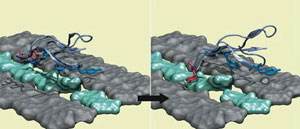 Scientists have used an SDSC supercomputer to help improve cellulose conversion to ethanol.
Scientists have used an SDSC supercomputer to help improve cellulose conversion to ethanol.
Their “virtual molecules” show how the enzyme complex may change shape to straddle a broken cellulose chain, gaining a crucial foothold to digest cellulose into sugar molecules, which can then be fermented into ethanol.
A team of scientists has conducted molecular simulations at the San Diego Supercomputer Center (SDSC), based at UC San Diego. By using “virtual molecules,” they have discovered key steps in the intricate dance in which the enzyme acts as a molecular machine — attaching to bundles of cellulose, pulling up a single strand of sugar, and putting it onto a molecular conveyor belt where it is chopped into smaller sugar pieces.
Image courtesy of Ross Walker and Amit Chourasia, SDSC and Michael Crowley and Mark Nimlos, NREL.

